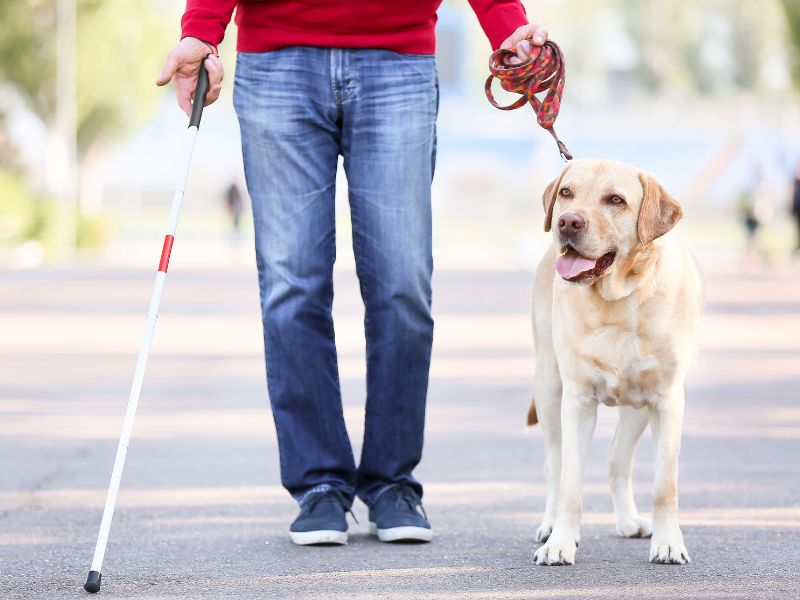Labradors are one of the most popular dog breeds in the world. They are known for their friendly and outgoing personalities, loyalty, and intelligence. However, despite their many positive traits, Labradors can sometimes be disobedient. This can be frustrating for their owners, who may not understand why their normally well-behaved dog is suddenly acting out.
There are several reasons why a Labrador may be disobedient. One common reason is that the dog simply doesn’t understand what is expected of them. Dogs don’t speak English, so it’s important for owners to communicate with their pets in a way that they can understand. Another reason for disobedience is a lack of exercise. Labradors are a high-energy breed that require plenty of physical activity to stay healthy and happy. Finally, disobedience can also be a sign of underlying health issues, such as pain or discomfort.
Reason 1: He Doesn’t Know What You Want Him to Do

Labradors are intelligent dogs, but they don’t speak English, so it’s important to teach them what you want them to do. Dogs need clear and consistent communication to understand what is expected of them. If you haven’t properly trained your Labrador, he may not understand what you want him to do. This can lead to disobedience and frustration for both you and your furry friend.
One way to ensure your Labrador understands what you want him to do is to use positive reinforcement. Rewarding good behavior with treats or praise can help your dog learn what is expected of him. It’s important to be patient and consistent when training your dog. Repetition is key, and it may take some time for your Labrador to learn new commands.
Another common mistake is using too many words or commands. Keep it simple and use one-word commands like “sit” or “stay.” This will help your dog understand what you want him to do and make it easier for him to follow your commands.
In conclusion, if your Labrador is disobedient, it may be because he doesn’t understand what you want him to do. Using positive reinforcement and simple commands can help your furry friend learn what is expected of him and lead to a happier and more obedient dog.
What Does That Word Mean?
Labrador owners may come across unfamiliar terms when researching their dog’s behavior. It is important to understand these terms to better communicate with trainers and veterinarians. Here are a few common terms and their meanings:
- Obedience: The ability of a dog to follow commands given by its owner.
- Stubbornness: A trait in which a dog ignores commands it has been trained to obey.
- Exercise: Physical activity that helps maintain a dog’s health and well-being.
- Positive reinforcement: A training technique that rewards a dog for good behavior.
- Negative reinforcement: A training technique that removes an unpleasant stimulus when a dog exhibits good behavior.
- Punishment: A training technique that applies an unpleasant stimulus when a dog exhibits bad behavior.
By understanding these terms, Labrador owners can better understand their dog’s behavior and work with trainers to improve obedience.
Modern Training Has a Different Approach
Modern dog training has evolved and changed over time. Unlike traditional training methods that rely on punishment and negative reinforcement, modern training focuses on positive reinforcement. Instead of punishing a dog for bad behavior, modern trainers reward good behavior with treats, toys, and praise.
This approach is more effective because it motivates the dog to learn and repeat good behavior. Dogs are intelligent creatures that can learn quickly when they are rewarded for their actions. Positive reinforcement also strengthens the bond between the dog and the owner, making training a more enjoyable experience for both.
Modern training also emphasizes the importance of understanding a dog’s body language and behavior. Trainers need to be able to read a dog’s cues and signals to determine what they are feeling or thinking. This helps trainers tailor their training methods to suit the dog’s needs and personality.
Overall, modern training is a more humane and effective approach to dog training. By focusing on positive reinforcement and understanding a dog’s behavior, trainers can help dogs become well-behaved and obedient pets.
Does It Mean the Same Everywhere?
Dogs can be disobedient because they don’t naturally assume that a word spoken in one place and under one set of conditions means the same in another place and under another set of conditions. For example, a Labrador could be trained to turn in a circle each time the owner says “spin” in the kitchen. However, when the owner says “spin” outside or in another room, the Labrador may not understand the command.
This is because dogs rely heavily on cues from their environment and the context in which a command is given. They may not understand that a word or command has the same meaning in different situations. Therefore, it is important to train a Labrador in different environments and under different conditions to ensure they understand the command in various situations.
Additionally, it is important to use consistent commands and cues to avoid confusion. For example, if the owner says “down” to mean lay down and then later says “down” to mean get off the couch, the Labrador may become confused and disobedient. By using consistent commands and cues, the Labrador will be able to understand what is expected of them in different situations.
Reason 2: He Isn’t Motivated to Do What You Want
Labradors are known to be one of the most trainable dog breeds. However, sometimes they can be stubborn and refuse to obey their owners. One reason for this disobedience could be a lack of motivation.
Just like humans, dogs need motivation to do something. If they don’t see any rewards or benefits from performing a task, they’re less likely to do it. For example, if your Labrador doesn’t see the point in coming when called, he might not do it.
To motivate your Labrador, you need to find out what he likes. Does he love treats? Does he enjoy playing with toys? Once you know what he likes, you can use those things as rewards for good behavior. For example, if your Labrador comes when called, give him a treat or play with his favorite toy.
It’s also important to make training fun for your dog. If he’s not enjoying the training sessions, he’s less likely to be motivated to obey. Incorporate games and play into your training routine to make it more enjoyable for your dog.
By finding out what motivates your Labrador and making training fun, you can increase his motivation to obey your commands. This will lead to a happier and more obedient dog.
Get Pippa’s Training Tips!
Labradors are intelligent and eager to please, but they can also be stubborn and strong-willed. If your Labrador is being disobedient, it can be frustrating and challenging to train them. Fortunately, Pippa Mattinson, a renowned dog trainer, has some tips to help you train your Labrador to be well-behaved.
First, Pippa recommends being consistent with your training. Dogs thrive on routine, so it’s essential to establish a consistent training schedule and stick to it. Set aside time each day to work on obedience training with your Labrador, and be patient and persistent.
Second, Pippa suggests using positive reinforcement to motivate your dog. Reward your dog with treats, praise, and affection when they follow commands correctly. This positive reinforcement will help your dog associate good behavior with positive outcomes.
Finally, Pippa advises using clear and concise commands when training your Labrador. Use short, easy-to-understand commands like “sit,” “stay,” and “come.” Be sure to use the same commands consistently, so your dog learns to associate each command with a specific behavior.
By following Pippa’s training tips, you can help your Labrador become a well-behaved and obedient companion. Remember to be patient, consistent, and positive in your training, and you’ll soon see the results you’re looking for.
Harder Tasks = Better Rewards
Labradors are known to be highly intelligent and trainable dogs. However, they can also be stubborn and disobedient, especially when they are not properly trained. One effective way to train a Labrador is to use a reward-based system. This means that the dog is rewarded for good behavior, rather than punished for bad behavior.
One important aspect of a reward-based system is to gradually increase the difficulty of the tasks that the dog is asked to perform. When a dog is first learning a new skill, it is important to start with simple tasks and reward the dog for completing them successfully. As the dog becomes more proficient, the tasks can become more challenging, and the rewards can become more substantial.
For example, if a Labrador is learning to sit on command, the owner might start by asking the dog to sit for a few seconds and then rewarding the dog with a treat. As the dog becomes more comfortable with this task, the owner can gradually increase the amount of time that the dog is asked to sit. Eventually, the owner can ask the dog to sit for longer periods of time and even in more distracting environments.
It is important to note that the rewards should match the difficulty of the task. If the task is too easy, the reward might not be enough to motivate the dog. On the other hand, if the task is too difficult, the dog might become frustrated and give up. By gradually increasing the difficulty of the tasks and the rewards, owners can help their Labradors become well-behaved and obedient pets.
The Dog Decides
Labradors are intelligent dogs that can become disobedient when they feel like they are in charge. They may decide that they do not want to follow commands because they feel like they know better. In this case, it is important to establish yourself as the leader of the pack.
One way to do this is by using positive reinforcement methods to reward good behavior. This could include giving treats or praise when the dog follows commands. It is important to be consistent with this approach so that the dog understands what is expected of them.
Another way to establish yourself as the leader is by using body language. This could include standing tall and using a firm voice when giving commands. It is important to avoid yelling or hitting the dog as this can lead to fear and aggression.
In some cases, it may be necessary to seek professional help from a dog trainer or behaviorist. They can provide additional guidance on how to establish yourself as the leader and address any underlying issues that may be causing the disobedience.
Overall, it is important to remember that the dog ultimately decides whether or not to follow commands. By using positive reinforcement methods and establishing yourself as the leader, you can increase the likelihood that the dog will obey.
Reason 3: He Is Too Excited to Do What You Want
Labradors are known for their high energy levels, and sometimes this can lead to disobedience. When a dog is too excited, it can be difficult for them to focus on what you want them to do. This can be especially true for young or untrained dogs.
One way to help your Labrador stay focused is to provide plenty of exercise and mental stimulation. This can include activities like playing fetch, going for walks, or practicing obedience training. By giving your dog an outlet for their energy, you can help them stay calmer and more focused when it’s time to listen to your commands.
Another way to help your dog stay calm is to avoid overstimulating them. This can include things like loud noises, sudden movements, or too much attention. By keeping a calm and consistent environment, you can help your dog stay focused and obedient.
Overall, it’s important to remember that every dog is different, and what works for one may not work for another. By understanding your dog’s needs and personality, you can help them become a well-behaved and obedient companion.
Bad Dog? No, Not Really
Labradors are known for their friendly and obedient nature. However, sometimes they may act disobediently. It is important to understand that a disobedient Labrador is not necessarily a bad dog. There could be a number of reasons why a Labrador is not following commands.
One reason could be lack of training. As mentioned in the previous section, dogs don’t speak English and it is important to communicate with them in a way they understand. A well-trained Labrador is more likely to behave well and follow commands.
Another reason could be lack of exercise or mental stimulation. Labradors are high-energy dogs and require regular exercise to stay healthy and happy. If they are not getting enough exercise, they may become bored and restless, leading to disobedience.
Lastly, fear or anxiety could also be a reason for disobedience. If a Labrador is scared or anxious, they may not follow commands. It is important to identify the source of their fear and work on reducing it through positive reinforcement training.
Overall, it is important to remember that a disobedient Labrador is not a bad dog. With proper training, exercise, and positive reinforcement, they can become well-behaved and obedient companions.
Readers Also Liked
Labradors are one of the most popular dog breeds in the world, and it’s no surprise that many people are interested in learning more about them. Here are a few resources that readers interested in Labradors may also find helpful:
- Labrador Retriever Training Tips: This article from the American Kennel Club provides some great tips for training Labradors, including advice on crate training, socialization, and obedience training.
- How to Stop Your Labrador from Jumping Up: Jumping up is a common problem for Labradors, but it can be frustrating for owners. This article provides some tips for stopping this behavior.
- 10 Fun Things to Do with Your Labrador: Labradors are energetic dogs that love to play and explore. This article provides some ideas for fun activities to do with your furry friend.
By reading these resources, readers can learn more about Labradors and how to care for them. Whether they’re dealing with disobedience or just looking for fun activities to do with their dog, these articles can provide some helpful tips and advice.















